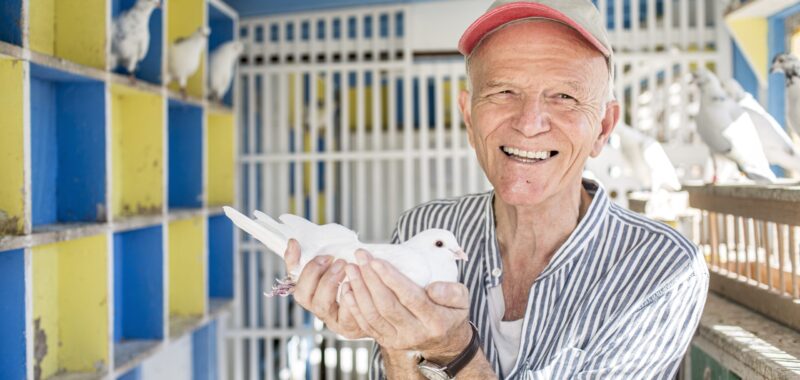Anton van Dalen, who documented the East Village from grittiness through gentrification with a distinctive, graphic vernacular, died at home in the neighborhood to which he dedicated his life on June 25 at the age of 86.
His visions of the East Village were alternately deserted and teeming, ravaged and full of secret life. “[I] have always worked from the perspective of starting with home, then street, neighborhood, city, world,” van Dalen wrote to Hyperallergic critic John Yau in a 2020 email. Indeed, he seemed to make no distinction between the functional and the aesthetic in his own life: Yau recalls cats and a dog weaving around free-roaming chickens in the studio and apartment, which he reared “so his children could have fresh eggs in the morning.”
For “Avenue A Cut-Out Theatre” (1995–2016), the work for which he is perhaps best known, van Dalen turned the home he lived in since 1972 into a microcosm of the East Village’s shifting currents, telling a story of the changing neighborhood via cutouts in a maquette of his apartment.

Van Dalen was born to a conservative Calvinist family in the city of Amstelveen in the Netherlands in 1938. Dutch artists like Van Gogh, Rembrandt, and Vermeer influenced his work in their depictions of life in granular, commonplace, and sometimes vulgar detail. The destruction of the war, too, would mark van Dalen’s art throughout his life, as would the steadfast gentleness needed to weather such devastation. Even as his family’s assets were seized by the Nazis, he began rearing pigeons: He would keep a hand-painted coop on the roof of his East Village apartment, and the bird symbolized freedom and community across his oeuvre.
The artist graduated from the Amsterdamse Grafische School in 1954; that same year, his family fled for Toronto. In 1966, van Dalen arrived in his beloved East Village. “At that time,” he told Tiernan Morgan in a 2016 Hyperallergic interview, it “literally looked like a scene from World War II.” Still, amid that new scene of chaos, he found ways of cultivating an art-as-life approach. He took his notebook to the streets, documenting the neighborhood with humor and pathos.
Van Dalen found community not just through happenstance, but through dogged effort. A two-to-three-year process of dialing a number he found for New Yorker cartoonist Saul Steinberg in a phone book finally led to an assistantship, a position that lasted three decades. “I went to all the galleries,” he told Hyperallergic. “I wasn’t starving for recognition, but I wanted to feel that I was participating in some way.”

A friend led him to alternative spaces like ABC No Rio, which in turn folded him into neighborhood collectives like PAD/D and Group Material. There, he met artists including Martin Wong and David Wojnarowicz, who helped him sharpen his work via a sense of like-minded thinking. “Before I met all these people I felt like a dog that had its tail tucked between its legs,” he said. “They made me feel that what I was doing wasn’t some sort of a side-show.”
Van Dalen’s work in the decades to follow embody the coalescing of the interests and commitments that shaped his upbringing and development. “Work & Nature” (1997), a series of porcelain and enamel steel plates sited at the Nevins Street subway station in Brooklyn, addresses his public with a tribute to its acts of both work and care: planting a tree, playing a guitar. In “Crusade” (2019), an object that appears at once organic and technological spits out bombs in the form of crucifixes, nodding to the fervor and destruction of patriotism.
During the COVID-19 lockdowns, van Dalen noted the prevalence of a “military language” that recalled his wartime memories, he shared with Yau in 2020. But as always, he channeled a humanistic perspective into his response, creating a series of iconographic drawings made on blue-lined white paper. Of all artist archetypes, Yau wrote, “van Dalen represents the least acknowledged: the non-heroic, civic-minded observer and chronicler.”
Van Dalen is survived by an older brother, Leen; his children, Marinda and Jason; their spouses, René van Haaften and Ali Villagra; and grandchildren Cleo, Aster, and Diego.


